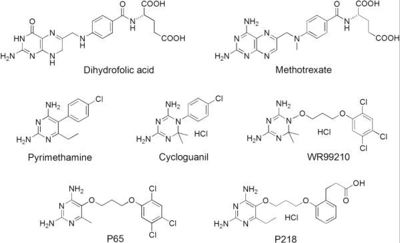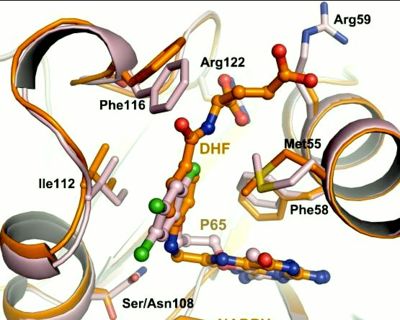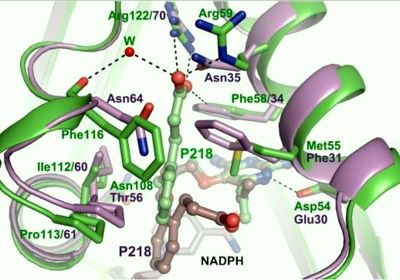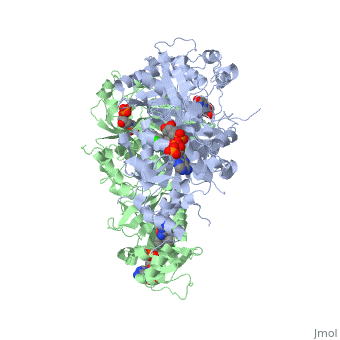Mutant, Drug Resistant PfDHFR
The
of PfDHFR has four
within the active site: N51I, C59R, S108N, and I164L.[5] These mutations cause preferential decreased binding affinities of inhibitors, a huge factor being steric clashing, while having less of an effect on biological substrates. For pyrimethamine and cycloguanil specifically, the S108N mutation greatly effects their ability to bind the enzyme due to the drugs' rigid chlorophenyl substituents. The S108N mutation is also recognized as the the first mutation to have come about in the enzyme. The other mutations further decrease the binding affinities of inhibitors by resulting in conformational and other changes. In an effort to mitigate the effect of the mutations, the commonly occurring mutations and quadruple mutant must be addressed in the research of new PfDHFR targeting drugs.
 [6]
[6]
A first step in this direction was to experiment with the drug , a 4,6-diamino-1,2-dihydro-1,3,5-triazine that, with its (2,4,5-trichlorophenoxy)propoxy side chain, addressed the steric clash that was subjected to with a Ser108Asn mutation. However further research with this drug was stopped because of its gastrointestinal toxicity in humans and low bioavailbility.[6] Wr99210, like cycloguanil, was significantly more basic than pyrimethamine, a pyrimidine and slightly acidic substance to match that of the gastrointestinal track, and thus was not readily absorbed in the intestines. When present in the gastrointestinal track, the triazines were fully protonated while the 2,4-diaminopyrimidines were present as a mixture of protonated and unprotonated. To test if protonation affected the bioavailability, a less basic compound with a 2,4-diaminopyrimidine scaffold was synthesized called P65. When it was compared via in vitro and in vivo experiments to Wr99210, P65 was shown to have significantly higher absorption in vivo. Thus, P65 was chosen as the basis for more research and the later discussed drug, P218. It was reasoned that protonation most likely interferes with absorption via passive diffusion and though Wr99210 was effective at getting deep into the mutant PfDHFR active site, its protonated state in the acidic gastrointestinal track would have made it unsuccessful as an oral drug, especially in comparison to its diaminopyrimidine analog, P65.
 [6]
[6]
P218
It was resolved that a structure containing 2,4-diaminopyrimidine anchor, such as that of P65, on a new drug would provide a solution for the steric hindrance present with pyrimethamine because of its rigid chlorophenyl group. This anchor allows deep binding into the active site of PfDHFR. On the other end of the molecule connected by a flexible, five-atom linker region, there would be a carboxyl group, that would form strong hydrogen bonds with the conserved residue. The flexible linker would reduce the chance of resistance from mutations because of its decreased specificity that can occur due to the strong anchor and other end with hydrogen bonds. These ideas culminated into the formation of P218.
There are three regions of the DHFR active site around the conserved arginine that differ between and Plasmodium falciparum that allow a drug to target the PfDHFR specifically while not harming that of humans. The Met55, Cys/Arg59, and Phe116 residues in the PfDHFR are replaced by Phe31, Gln35, and Asn64 at structurally equivalent positions in human DHFR which are crucial differentiations that can be taken advantage of by inhibitors, especially with a carboxyl group, to control species specificity. The plan in devising a compound, such as P218, that would interact with the region surrounding the conserved arginine residue mentioned above is that the compound would interact with the while leaving the and thus human DHFR alone. This design and intent for P218 was shown to be successful. In the quadruple mutant of PfDHFR, the P218 carboxylate side chain makes two hydrogen bonds with the Arg122 residue while in human DHFR, it has no interaction with the Arg70 residue. In the human active site, the P218 side chain to folds back toward its pyrimidine, which pushes Phe31 into a position toward the back of the substrate binding site further preventing the side-chain hydrogen bond formation with Arg70.[6] The changes in residues around Arg70 sterically prevent P218 from interacting with the residue like it does in PfDHFR.
 [6]
[6]
In addition to the hydrogen bonding interactions by the P218 carboxyl group with Arg122, there are also strong hydrogen bonding interactions with another higher conserved residue, Phe 58. This interaction is another aid in helping P218 overcome resistance due to amino acid mutations in the active site. Phe58 is highly unlikely to be mutated because it would likely have adverse effects on the DHF substrate binding and negatively effect the functioning of the malaria protist. [6] During in vitro studies, P218 was shown to be very active against the quadruple mutant, pyrimethamine resistant PfDHFR. [6] In vivo, it was also shown to be very active against quadruple mutant PfDHFR in SCID mice. [6] This high level of inhibitor activity is also coupled with its success of being species selective and not causing any host toxicity at reasonable levels. However, there were experiments performed and it was found that threshold of adverse effects was about 100 mg/kg/d. [6]
 [6]
[6]
Due to P218 fitting well within the DHF substrate envelope, resistance to P218 would not be favorable to the organism because it could lead to adverse effects of DHF substrate binding and parasite fitness. [6] Additionally, the Ser/Asn108 mutation does not effect the binding of P218 like it would for pyrimethamine and its rigid chlorophenyl group, as mentioned previously. It's also shown that an oxygen of the carboxyl group of P218 slightly penetrates the DHF substrate envelope to allow for increased hydrogen bonding interaction with the highly conserved Arg122 and Phe58 residues over that of the DHF substrate.
Conclusions
P218 has been determined to be an effective inhibitor of both wild-type and mutant, drug resistant PfDHFR, minimize host toxicity, and have reasonable bioavailability (46%).[6] The key structural characteristics of the compound that allow for this are its pyrimidine side-chain flexibility and carboxylate group that forms hydrogen bonds selectively with the conserved arginine in PfDHFR. This ability to be of this inhibitor to overcome mutant forms of the enzyme and still be highly effective is really important to the future of antimalarial drugs. The species specific design is also greatly important to the drug in order to avoid host toxicity. P218 is thus a good candidate for further research as a malarial drug because of its shown promise to help to solve the current problem of drug resistant malaria effectively.





